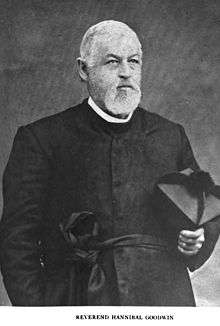Hannibal Goodwin
| Hannibal Goodwin | |
|---|---|
 | |
| Born |
April 21, 1822 Taughannock, New York |
| Died | December 31, 1900 (aged 78) |

Hannibal Williston Goodwin (April 21, 1822 – December 31, 1900), was an Episcopal priest at the House of Prayer Episcopal Church and Rectory in Newark, New Jersey, patented a method for making transparent, flexible roll film out of nitrocellulose film base, which was used in Thomas Edison's Kinetoscope, an early machine for viewing motion pictures.[1]
Biography
He was born on April 21, 1822 in Taughannock, New York.
He was motivated to search for a non-breakable, and clear substance on which he could place the images he utilized in his Biblical teachings. On May 2, 1887, the year Reverend Goodwin retired from the church he had served for twenty years, he filed a patent for "a photographic pellicle and process of producing same ... especially in connection with roller cameras", but the patent was not granted until 13 September 1898.[2] In the meantime, George Eastman had already started production of roll-film using his own process.
In 1900, Goodwin set up the Goodwin Film and Camera Company, but before film production had started he was involved in a street accident near a construction site and died on December 31, 1900 from his injuries.
Legacy
His patent was sold to Ansco who successfully sued Eastman Kodak for infringement of the patent and was awarded $5,000,000 in 1914.[3]
References
- ↑ Greg Hatala (17 December 2013). "Made in Jersey: Flexible film - before digital, we waited to see what developed". The Star-Ledger. Retrieved 2 February 2014.
- ↑ U.S. Patent 610,861
- ↑ "Kodak Concern to Make Big Payment to Goodwin Company.". New York Times. March 27, 1914. Retrieved 2010-09-18.
A settlement has been reached between the Goodwin Film and Camera Company and the Eastman Kodak Company concerning the suit brought in the Federal District Court by the former for an accounting of the profits derived from the sale of photographic films prepared according to the patent taken out by the late Rev. Hannibal Goodwin of Newark in 1898. The details of it have not been announced, but it is understood to provide for tile payment of a large sum of money by ...
External links
| Wikimedia Commons has media related to Hannibal Goodwin. |
- PBS History of Photography timeline
- Dr. Dan's Movie Page
- Invention & Technology article about Goodwin/Eastman patent dispute